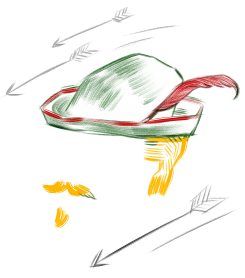The infamous English bandit and his band of merry men take over the Hart House stage with a unique brand of comic absurdity in Robin Hood: The Legendary Musical Comedy. Many members of the cast and crew — including director Jesse MacLean — were involved in the development of this original Canadian show back in 2005, and their gleeful rendition of the classic English folktale is a pleasure to behold.
Wittily crafted and captivatingly executed, Hart House’s latest production is a delightful take on the beloved legend of Robin Hood. In Robin Hood: The Legendary Musical, the hero of the story emerges from Sherwood Forest at a time when the English poor are paying ludicrous taxes and being manipulated into funding a friar’s alcohol addiction. Realizing that he can use his thieving ways to redistribute wealth, Robin forms a band of followers with a mission to bridge the gap between rich and poor. Although one could enjoy the show exclusively for its tongue-in-cheek humour, Robin Hood’s provocative statements about the nature of social class are both witty and relevant.
As the tights-clad star of the show, Daniel James embodies the charming, dignified, and innovative Robin of Locksley. James’ strong vocals seem effortless, but it is his ability to adopt a range of different personas — including a French damsel in distress — that is particularly delightful. It’s impossible not to root for James’ Robin Hood, even after the character betrays his selfish motivations for taking from the rich and giving to the poor in the catchy song “Generosity.”
But it is Kevin MacPherson as Prince John and William Foley as Sheriff of Nottingham who never fail to get the audience roaring with laughter. Macpherson and Foley work together marvelously, endowing their despicable, money-hungry characters with a hilarious naivety. When the prince and the sheriff aren’t waddling, prancing, or sliding across the stage, the duo’s nonsensical dialogue keeps the audience happily anticipating whatever ridiculous thing these characters are going to say next.
Robin Hood shines during elaborate musical numbers, when the entire cast is on stage. Actors dressed in appropriately outlandish costumes whiz across the stage, while bows and arrows fly about with chaotic perfection. The choreography, which incorporates both dance and stage-fighting routines, is remarkably effective and well-performed by the talented cast.
The play’s twists on classic plotlines and send-ups of clichéd themes of unrequited love are consistently sharp, while “meta” references to the performance paradoxically draw the audience into the world of the play. A song called “After Intermission,” for example, bridges the transition from one act to the next, as though the 15-minute break is part of the story.
Whether you are looking for an astute commentary on social class, or just want to watch a bunch of men in tights dancing across a stage, it is impossible to leave Robin Hood without feeling at least a little upbeat. In all likelihood, you’ll find yourself cheerfully humming one of the play’s catchy tunes as you make your way out of the theatre.



